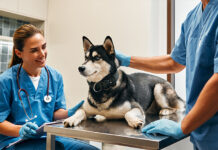
10 Warning Signs of an Unhealthy Dog: An In-Depth Guide for the Educated Pet Owner
As a knowledgeable pet owner, you understand that dogs can’t communicate their ailments as humans do. It’s crucial to recognize subtle signs of illness for early intervention. Here’s an in-depth look at 10 warning signs of an unhealthy dog, with insights tailored for the educated pet owner.
1. Changes in Appetite or Drinking Habits
Alterations in eating or drinking patterns can be symptomatic of various conditions. An increased thirst could indicate diabetes mellitus, especially if accompanied by weight loss and increased urination. Conversely, a decrease in appetite or water intake might suggest gastrointestinal issues or even organ dysfunction. Monitoring your dog’s daily intake can provide valuable data for veterinary assessment.
2. Unexplained Weight Loss or Gain
Rapid weight loss, even with a normal appetite, could be a sign of malabsorption disorders, cancer, or chronic protein-losing intestinal conditions. On the other hand, unexplained weight gain might indicate metabolic disorders like hypothyroidism. Regular body condition scoring can help in early detection.
3. Abnormal Stool or Urination
Consistency, frequency, and appearance of stool and urine offer vital health indicators. For instance, black, tarry stools could indicate gastrointestinal bleeding, while pale stools might suggest biliary or liver issues. Similarly, changes in urination – frequency, color, smell, or volume – can signal kidney disease or diabetes.
4. Persistent Itching or Skin Changes
Chronic skin issues often point to allergies, either environmental or food-related. Secondary infections with bacteria or yeast can complicate these conditions. A thorough dermatological examination, possibly including allergy testing or diet trials, can be necessary for diagnosis and management.
5. Lethargy or Decreased Activity
A decrease in energy levels can be one of the most subtle yet significant signs. It could indicate a range of issues from heart disease to metabolic disorders. Understanding your dog’s normal activity levels and noting any changes can be key in early disease detection.
6. Behavioral Changes
Changes in behavior, such as increased irritability or anxiety, can be indicative of pain or discomfort. Cognitive dysfunction should also be a consideration in senior dogs, presenting as disorientation or changes in sleep patterns. A thorough neurological and behavioral assessment is crucial.
7. Coughing, Wheezing, or Difficulty Breathing
These symptoms can be associated with heart disease, especially in breeds predisposed to such conditions. Chronic bronchitis or allergic airway disease are other possibilities. Cardiac and respiratory evaluations, including radiographs and possibly echocardiography, may be warranted.
8. Nasal or Eye Discharge
Persistent discharge, particularly if it’s purulent or bloody, can indicate infections, foreign bodies, or even tumors. In-depth ophthalmic or nasal examinations, possibly including imaging or endoscopy, might be necessary.
9. Gait Changes or Reluctance to Move
This can be a sign of musculoskeletal pain, arthritis, or neurological issues. Detailed orthopedic and neurological evaluations are important, and in some cases, advanced imaging like MRI or CT scans may be required.
10. Bad Breath or Dental Issues
Periodontal disease is not just a local issue; it can have systemic implications. Regular dental check-ups and cleanings are vital. Bad breath coupled with difficulty eating or pawing at the mouth warrants a thorough dental examination under anesthesia.
Conclusion
Your role as an educated pet owner is crucial in early disease detection and management. Regular health checks, being attuned to your dog’s normal behavior, and maintaining open communication with your veterinarian are key. Your proactive approach can make a significant difference in your dog’s health and quality of life.
Call to Action
Stay informed, stay observant, and always prioritize your dog’s health. Share this information with fellow pet enthusiasts to foster a community of well-informed, proactive pet owners.











